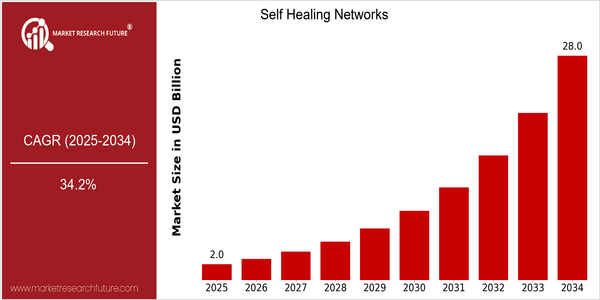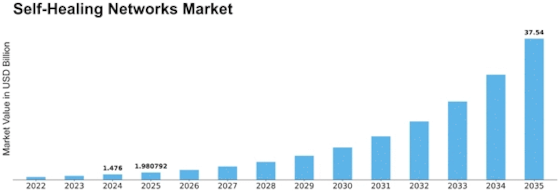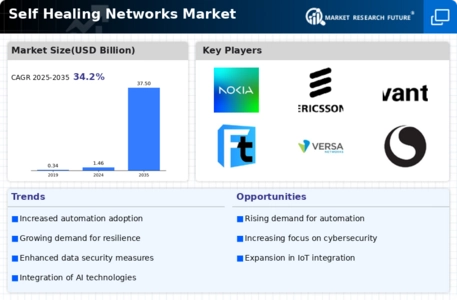-
EXECUTIVE SUMMARY
-
MARKET INTRODUCTION
-
Definition
-
Scope of the Study
- Research Objective
- Assumptions
- Limitations
-
RESEARCH METHODOLOGY
-
Overview
-
Data Mining
-
Secondary Research
-
Primary Research
- Primary Interviews
- Breakdown of Primary Respondents
-
and Information Gathering Process
-
Forecasting Model
-
Market Size Estimation
- Bottom-Up Approach
- Top-Down Approach
-
Data Triangulation
-
Validation
-
MARKET DYNAMICS
-
Overview
-
Drivers
-
Restraints
-
Opportunities
-
MARKET FACTOR ANALYSIS
-
Value Chain Analysis
-
Porter’s Five Forces Analysis
- Bargaining Power
- Threat of New Entrants
- Threat of Substitutes
- Intensity of Rivalry
-
of Suppliers
-
5.2.2.
-
Bargaining Power of Buyers
-
COVID-19 Impact Analysis
- Market Impact Analysis
- Regional Impact
- Opportunity and
-
Threat Analysis
-
6.
-
GLOBAL SELF-HEALING NETWORKS MARKET, BY COMPONENT
-
Overview
-
Solutions
-
Services
-
GLOBAL SELF-HEALING NETWORKS MARKET, BY NETWORK
-
TYPE
-
Overview
-
Physical
-
Virtual
-
Hybrid
-
GLOBAL SELF-HEALING
-
NETWORKS MARKET, BY ORGANIZATION SIZE
-
Overview
-
Large Enterprises
-
SMEs
-
GLOBAL SELF-HEALING NETWORKS MARKET, BY DEPLOYMENT MODE
-
Overview
-
On-premises
-
Cloud
-
GLOBAL SELF-HEALING
-
NETWORKS MARKET, BY APPLICATION
-
Overview
-
Network Provisioning
-
Network Bandwidth Monitoring
-
Policy Management
-
Security Compliance Management
-
Root Cause Analysis
-
Network Traffic
-
Management
-
10.8.
-
Network Access Control
-
10.9.
-
Other Application
-
11.
-
GLOBAL SELF-HEALING NETWORKS MARKET, BY VERTICALS
-
Overview
-
IT and ITES
-
BFSI
-
Media and Entertainment
-
Healthcare and Life Sciences
-
Telecom
-
Retail and Consumer Goods
-
Education
-
Other Verticals
-
GLOBAL SELF-HEALING
-
NETWORKS MARKET, BY REGION
-
Overview
-
North America
- U.S.
- Canada
-
Europe
- Germany
- France
- U.K
- Italy
- Spain
- Rest of Europe
-
Asia-Pacific
- China
- India
- Japan
- South Korea
- Australia
- Rest of Asia-Pacific
-
Rest of the World
- Middle East
- Africa
- Latin America
-
COMPETITIVE LANDSCAPE
-
Overview
-
Competitive Analysis
-
Market Share Analysis
-
Major Growth Strategy in the Global Self-Healing
-
Networks Market,
-
13.5.
-
Competitive Benchmarking
-
Leading Players in Terms of Number of Developments in the Global
-
Self-Healing Networks Market,
-
Key developments and Growth Strategies
- New Type Launch/Booking Channel Deployment
- Merger &
- Sales & Operating Income, 2022
- Major Players R&D Expenditure. 2022
-
Acquisitions
-
13.7.3.
-
Joint Ventures
-
13.8.
-
Major Players Financial Matrix
-
COMPANY PROFILES
-
NOKIA
- Company Overview
- Financial Overview
- Types Offered
- Key Developments
- SWOT Analysis
- Key Strategies
-
Ericsson
- Company Overview
- Financial Overview
- Types Offered
- Key Developments
- SWOT Analysis
- Key Strategies
-
Fortra LLC
- Company Overview
- Financial Overview
- Types Offered
- Key Developments
- SWOT Analysis
- Key Strategies
-
Versa Networks,
-
Inc.
-
14.4.1.
-
Company Overview
-
14.4.2.
-
Financial Overview
-
14.4.3.
-
Types Offered
-
14.4.4.
-
Key Developments
-
14.4.5.
-
SWOT Analysis
-
14.4.6.
-
Key Strategies
-
14.5.
-
Ivanti
-
14.5.1.
-
Company Overview
-
14.5.2.
-
Financial Overview
-
14.5.3.
-
Types Offered
-
14.5.4.
-
Key Developments
-
14.5.5.
-
SWOT Analysis
-
14.5.6.
-
Key Strategies
-
14.6.
-
IBM CORPORATION
-
14.6.1.
-
Company Overview
-
14.6.2.
-
Financial Overview
-
14.6.3.
-
Types Offered
-
14.6.4.
-
Key Developments
-
14.6.5.
-
SWOT Analysis
-
14.6.6.
-
Key Strategies
-
14.7.
-
Cisco Systems, Inc.
-
14.7.1.
-
Company Overview
-
14.7.2.
-
Financial Overview
-
14.7.3.
-
Types Offered
-
14.7.4.
-
Key Developments
-
14.7.5.
-
SWOT Analysis
-
14.7.6.
-
Key Strategies
-
14.8.
-
VMware, Inc.
-
14.8.1.
-
Company Overview
-
14.8.2.
-
Financial Overview
-
14.8.3.
-
Types Offered
-
14.8.4.
-
Key Developments
-
14.8.5.
-
SWOT Analysis
-
14.8.6.
-
Key Strategies
-
14.9.
-
CommScope
-
14.9.1.
-
Company Overview
-
14.9.2.
-
Financial Overview
-
14.9.3.
-
Types Offered
-
14.9.4.
-
Key Developments
-
14.9.5.
-
SWOT Analysis
-
14.9.6.
-
Key Strategies
-
14.10.
-
Appnomic
-
14.10.1.
-
Company Overview
-
14.10.2.
-
Financial Overview
-
14.10.3.
-
Types Offered
-
14.10.4.
-
Key Developments
-
14.10.5.
-
SWOT Analysis
-
14.10.6.
-
Key Strategies
-
15.
-
APPENDIX
-
15.1.
-
References
-
15.2.
-
Related Reports
-
-
LIST OF TABLES
-
GLOBAL SELF-HEALING
-
NETWORKS MARKET, SYNOPSIS, 2018-2032
-
GLOBAL SELF-HEALING NETWORKS MARKET, ESTIMATES &
-
FORECAST, 2018-2032 (USD BILLION)
-
GLOBAL SELF-HEALING NETWORKS MARKET, BY COMPONENT, 2018-2032
-
(USD BILLION)
-
TABLE
-
GLOBAL SELF-HEALING NETWORKS MARKET, BY NETWORK TYPE, 2018-2032 (USD BILLION)
-
GLOBAL SELF-HEALING
-
NETWORKS MARKET, BY ORGANIZATION SIZE, 2018-2032 (USD BILLION)
-
GLOBAL SELF-HEALING NETWORKS
-
MARKET, BY DEPLOYMENT MODE, 2018-2032 (USD BILLION)
-
GLOBAL SELF-HEALING NETWORKS MARKET, BY APPLICATION,
-
GLOBAL SELF-HEALING NETWORKS MARKET, BY VERTICALS, 2018-2032
-
(USD BILLION)
-
TABLE
-
NORTH AMERICA SELF-HEALING NETWORKS MARKET, BY COMPONENT, 2018-2032 (USD BILLION)
-
NORTH AMERICA
-
SELF-HEALING NETWORKS MARKET, BY NETWORK TYPE, 2018-2032 (USD BILLION)
-
NORTH AMERICA
-
SELF-HEALING NETWORKS MARKET, BY ORGANIZATION SIZE, 2018-2032 (USD BILLION)
-
NORTH AMERICA
-
SELF-HEALING NETWORKS MARKET, BY DEPLOYMENT MODE, 2018-2032 (USD BILLION)
-
NORTH AMERICA
-
SELF-HEALING NETWORKS MARKET, BY APPLICATION, 2018-2032 (USD BILLION)
-
NORTH AMERICA
-
SELF-HEALING NETWORKS MARKET, BY COUNTRY, 2018-2032 (USD BILLION)
-
NORTH AMERICA SELF-HEALING
-
NETWORKS MARKET, BY VERTICALS, 2018-2032 (USD BILLION)
-
U.S. SELF-HEALING NETWORKS MARKET, BY COMPONENT,
-
U.S. SELF-HEALING NETWORKS MARKET, BY NETWORK TYPE, 2018-2032
-
(USD BILLION)
-
TABLE
-
U.S. SELF-HEALING NETWORKS MARKET, BY ORGANIZATION SIZE, 2018-2032 (USD BILLION)
-
U.S. SELF-HEALING
-
NETWORKS MARKET, BY DEPLOYMENT MODE, 2018-2032 (USD BILLION)
-
U.S. SELF-HEALING NETWORKS MARKET, BY APPLICATION,
-
U.S. SELF-HEALING NETWORKS MARKET, BY VERTICALS, 2018-2032
-
(USD BILLION)
-
TABLE
-
CANADA SELF-HEALING NETWORKS MARKET, BY COMPONENT, 2018-2032 (USD BILLION)
-
CANADA SELF-HEALING
-
NETWORKS MARKET, BY NETWORK TYPE, 2018-2032 (USD BILLION)
-
CANADA SELF-HEALING NETWORKS MARKET, BY
-
ORGANIZATION SIZE, 2018-2032 (USD BILLION)
-
CANADA SELF-HEALING NETWORKS MARKET, BY
-
DEPLOYMENT MODE, 2018-2032 (USD BILLION)
-
CANADA SELF-HEALING NETWORKS MARKET, BY APPLICATION,
-
CANADA SELF-HEALING NETWORKS MARKET, BY VERTICALS, 2018-2032
-
(USD BILLION)
-
TABLE
-
EUROPE SELF-HEALING NETWORKS MARKET, BY COMPONENT, 2018-2032 (USD BILLION)
-
EUROPE SELF-HEALING
-
NETWORKS MARKET, BY NETWORK TYPE, 2018-2032 (USD BILLION)
-
EUROPE SELF-HEALING NETWORKS MARKET, BY
-
ORGANIZATION SIZE, 2018-2032 (USD BILLION)
-
EUROPE SELF-HEALING NETWORKS MARKET, BY
-
DEPLOYMENT MODE, 2018-2032 (USD BILLION)
-
EUROPE SELF-HEALING NETWORKS MARKET, BY APPLICATION,
-
EUROPE SELF-HEALING NETWORKS MARKET, BY COUNTRY, 2018-2032
-
(USD BILLION)
-
TABLE
-
EUROPE SELF-HEALING NETWORKS MARKET, BY VERTICALS, 2018-2032 (USD
-
GERMANY SELF-HEALING
-
NETWORKS MARKET, BY COMPONENT, 2018-2032 (USD BILLION)
-
GERMANY SELF-HEALING NETWORKS MARKET, BY
-
NETWORK TYPE, 2018-2032 (USD BILLION)
-
GERMANY SELF-HEALING NETWORKS MARKET, BY ORGANIZATION
-
SIZE, 2018-2032 (USD BILLION)
-
GERMANY SELF-HEALING NETWORKS MARKET, BY DEPLOYMENT MODE,
-
GERMANY SELF-HEALING NETWORKS MARKET, BY APPLICATION, 2018-2032
-
(USD BILLION)
-
TABLE
-
GERMANY SELF-HEALING NETWORKS MARKET, BY VERTICALS, 2018-2032 (USD
-
FRANCE SELF-HEALING
-
NETWORKS MARKET, BY COMPONENT, 2018-2032 (USD BILLION)
-
FRANCE SELF-HEALING NETWORKS MARKET, BY
-
NETWORK TYPE, 2018-2032 (USD BILLION)
-
FRANCE SELF-HEALING NETWORKS MARKET, BY ORGANIZATION
-
SIZE, 2018-2032 (USD BILLION)
-
FRANCE SELF-HEALING NETWORKS MARKET, BY DEPLOYMENT MODE, 2018-2032
-
(USD BILLION)
-
TABLE
-
FRANCE SELF-HEALING NETWORKS MARKET, BY APPLICATION, 2018-2032 (USD BILLION)
-
FRANCE SELF-HEALING
-
NETWORKS MARKET, BY VERTICALS, 2018-2032 (USD
-
U.K SELF-HEALING NETWORKS MARKET, BY COMPONENT,
-
U.K SELF-HEALING NETWORKS MARKET, BY NETWORK TYPE, 2018-2032
-
(USD BILLION)
-
TABLE
-
U.K SELF-HEALING NETWORKS MARKET, BY ORGANIZATION SIZE, 2018-2032 (USD BILLION)
-
U.K SELF-HEALING
-
NETWORKS MARKET, BY DEPLOYMENT MODE, 2018-2032 (USD BILLION)
-
U.K SELF-HEALING NETWORKS MARKET, BY APPLICATION,
-
U.K SELF-HEALING NETWORKS MARKET, BY VERTICALS, 2018-2032
-
(USD
-
TABLE
-
ITALY SELF-HEALING NETWORKS MARKET, BY COMPONENT, 2018-2032 (USD BILLION)
-
ITALY SELF-HEALING
-
NETWORKS MARKET, BY NETWORK TYPE, 2018-2032 (USD BILLION)
-
ITALY SELF-HEALING NETWORKS MARKET, BY ORGANIZATION
-
SIZE, 2018-2032 (USD BILLION)
-
ITALY SELF-HEALING NETWORKS MARKET, BY DEPLOYMENT MODE, 2018-2032
-
(USD BILLION)
-
TABLE
-
ITALY SELF-HEALING NETWORKS MARKET, BY APPLICATION, 2018-2032 (USD BILLION)
-
ITALY SELF-HEALING
-
NETWORKS MARKET, BY VERTICALS, 2018-2032 (USD
-
SPAIN SELF-HEALING NETWORKS MARKET, BY COMPONENT,
-
SPAIN SELF-HEALING NETWORKS MARKET, BY NETWORK TYPE, 2018-2032
-
(USD BILLION)
-
TABLE
-
SPAIN SELF-HEALING NETWORKS MARKET, BY ORGANIZATION SIZE, 2018-2032 (USD BILLION)
-
SPAIN SELF-HEALING
-
NETWORKS MARKET, BY DEPLOYMENT MODE, 2018-2032 (USD BILLION)
-
SPAIN SELF-HEALING NETWORKS MARKET, BY APPLICATION,
-
SPAIN SELF-HEALING NETWORKS MARKET, BY VERTICALS, 2018-2032
-
(USD
-
TABLE
-
REST OF EUROPE SELF-HEALING NETWORKS MARKET, BY COMPONENT, 2018-2032 (USD BILLION)
-
REST OF EUROPE
-
SELF-HEALING NETWORKS MARKET, BY NETWORK TYPE, 2018-2032 (USD BILLION)
-
REST OF EUROPE
-
SELF-HEALING NETWORKS MARKET, BY ORGANIZATION SIZE, 2018-2032 (USD BILLION)
-
REST OF EUROPE
-
SELF-HEALING NETWORKS MARKET, BY DEPLOYMENT MODE, 2018-2032 (USD BILLION)
-
REST OF EUROPE
-
SELF-HEALING NETWORKS MARKET, BY APPLICATION, 2018-2032 (USD BILLION)
-
REST OF EUROPE
-
SELF-HEALING NETWORKS MARKET, BY VERTICALS, 2018-2032 (USD
-
ASIA PACIFIC SELF-HEALING NETWORKS MARKET,
-
BY COMPONENT, 2018-2032 (USD BILLION)
-
ASIA PACIFIC SELF-HEALING NETWORKS MARKET, BY NETWORK
-
TYPE, 2018-2032 (USD BILLION)
-
ASIA PACIFIC SELF-HEALING NETWORKS MARKET, BY ORGANIZATION
-
SIZE, 2018-2032 (USD BILLION)
-
ASIA PACIFIC SELF-HEALING NETWORKS MARKET, BY DEPLOYMENT MODE,
-
ASIA PACIFIC SELF-HEALING NETWORKS MARKET, BY APPLICATION,
-
ASIA PACIFIC SELF-HEALING NETWORKS MARKET, BY COUNTRY, 2018-2032
-
(USD BILLION)
-
TABLE
-
ASIA PACIFIC SELF-HEALING NETWORKS MARKET, BY VERTICALS, 2018-2032 (USD
-
CHINA SELF-HEALING
-
NETWORKS MARKET, BY COMPONENT, 2018-2032 (USD BILLION)
-
CHINA SELF-HEALING NETWORKS MARKET, BY NETWORK
-
TYPE, 2018-2032 (USD BILLION)
-
CHINA SELF-HEALING NETWORKS MARKET, BY ORGANIZATION SIZE,
-
CHINA SELF-HEALING NETWORKS MARKET, BY DEPLOYMENT MODE, 2018-2032
-
(USD BILLION)
-
TABLE
-
CHINA SELF-HEALING NETWORKS MARKET, BY APPLICATION, 2018-2032 (USD BILLION)
-
CHINA SELF-HEALING
-
NETWORKS MARKET, BY VERTICALS, 2018-2032 (USD
-
JAPAN SELF-HEALING NETWORKS MARKET, BY COMPONENT,
-
JAPAN SELF-HEALING NETWORKS MARKET, BY NETWORK TYPE, 2018-2032
-
(USD BILLION)
-
TABLE
-
JAPAN SELF-HEALING NETWORKS MARKET, BY ORGANIZATION SIZE, 2018-2032 (USD BILLION)
-
JAPAN SELF-HEALING
-
NETWORKS MARKET, BY DEPLOYMENT MODE, 2018-2032 (USD BILLION)
-
JAPAN SELF-HEALING NETWORKS MARKET, BY APPLICATION,
-
JAPAN SELF-HEALING NETWORKS MARKET, BY VERTICALS, 2018-2032
-
(USD
-
TABLE
-
INDIA SELF-HEALING NETWORKS MARKET, BY COMPONENT, 2018-2032 (USD BILLION)
-
INDIA SELF-HEALING
-
NETWORKS MARKET, BY NETWORK TYPE, 2018-2032 (USD BILLION)
-
INDIA SELF-HEALING NETWORKS MARKET, BY ORGANIZATION
-
SIZE, 2018-2032 (USD BILLION)
-
INDIA SELF-HEALING NETWORKS MARKET, BY DEPLOYMENT MODE, 2018-2032
-
(USD BILLION)
-
TABLE
-
INDIA SELF-HEALING NETWORKS MARKET, BY APPLICATION, 2018-2032 (USD BILLION)
-
INDIA SELF-HEALING
-
NETWORKS MARKET, BY VERTICALS, 2018-2032 (USD
-
SOUTH KOREA SELF-HEALING NETWORKS MARKET,
-
BY COMPONENT, 2018-2032 (USD BILLION)
-
SOUTH KOREA SELF-HEALING NETWORKS MARKET, BY NETWORK
-
TYPE, 2018-2032 (USD BILLION)
-
SOUTH KOREA SELF-HEALING NETWORKS MARKET, BY ORGANIZATION
-
SIZE, 2018-2032 (USD BILLION)
-
SOUTH KOREA SELF-HEALING NETWORKS MARKET, BY DEPLOYMENT MODE,
-
SOUTH KOREA SELF-HEALING NETWORKS MARKET, BY APPLICATION,
-
SOUTH KOREA SELF-HEALING NETWORKS MARKET, BY VERTICALS, 2018-2032
-
(USD
-
TABLE
-
AUSTRALIA SELF-HEALING NETWORKS MARKET, BY COMPONENT, 2018-2032 (USD BILLION)
-
AUSTRALIA SELF-HEALING
-
NETWORKS MARKET, BY NETWORK TYPE, 2018-2032 (USD BILLION)
-
AUSTRALIA SELF-HEALING NETWORKS MARKET,
-
BY ORGANIZATION SIZE, 2018-2032 (USD BILLION)
-
AUSTRALIA SELF-HEALING NETWORKS MARKET,
-
BY DEPLOYMENT MODE, 2018-2032 (USD BILLION)
-
AUSTRALIA SELF-HEALING NETWORKS MARKET,
-
BY APPLICATION, 2018-2032 (USD BILLION)
-
AUSTRALIA SELF-HEALING NETWORKS MARKET, BY VERTICALS,
-
TABLE
-
REST OF ASIA PACIFIC SELF-HEALING NETWORKS MARKET, BY COMPONENT, 2018-2032 (USD
-
BILLION)
-
TABLE
-
REST OF ASIA PACIFIC SELF-HEALING NETWORKS MARKET, BY NETWORK TYPE, 2018-2032
-
(USD BILLION)
-
TABLE
-
REST OF ASIA PACIFIC SELF-HEALING NETWORKS MARKET, BY ORGANIZATION SIZE, 2018-2032
-
(USD BILLION)
-
TABLE
-
REST OF ASIA PACIFIC SELF-HEALING NETWORKS MARKET, BY DEPLOYMENT MODE, 2018-2032
-
(USD BILLION)
-
TABLE
-
REST OF ASIA PACIFIC SELF-HEALING NETWORKS MARKET, BY APPLICATION, 2018-2032
-
(USD BILLION)
-
TABLE
-
REST OF ASIA PACIFIC SELF-HEALING NETWORKS MARKET, BY VERTICALS, 2018-2032 (USD
-
TABLE 114
-
REST OF THE WORLD SELF-HEALING NETWORKS MARKET, BY COMPONENT, 2018-2032 (USD BILLION)
-
REST OF THE
-
WORLD SELF-HEALING NETWORKS MARKET, BY NETWORK TYPE, 2018-2032 (USD BILLION)
-
REST OF THE
-
WORLD SELF-HEALING NETWORKS MARKET, BY ORGANIZATION SIZE, 2018-2032 (USD BILLION)
-
REST OF THE
-
WORLD SELF-HEALING NETWORKS MARKET, BY DEPLOYMENT MODE, 2018-2032 (USD BILLION)
-
REST OF THE
-
WORLD SELF-HEALING NETWORKS MARKET, BY APPLICATION, 2018-2032 (USD BILLION)
-
REST OF THE
-
WORLD SELF-HEALING NETWORKS MARKET, BY COUNTRY, 2018-2032 (USD BILLION)
-
REST OF WORLD
-
SELF-HEALING NETWORKS MARKET, BY VERTICALS, 2018-2032 (USD
-
MIDDLE EAST SELF-HEALING NETWORKS MARKET,
-
BY COMPONENT, 2018-2032 (USD BILLION)
-
MIDDLE EAST SELF-HEALING NETWORKS MARKET, BY NETWORK
-
TYPE, 2018-2032 (USD BILLION)
-
MIDDLE EAST SELF-HEALING NETWORKS MARKET, BY ORGANIZATION
-
SIZE, 2018-2032 (USD BILLION)
-
MIDDLE EAST SELF-HEALING NETWORKS MARKET, BY DEPLOYMENT MODE,
-
MIDDLE EAST SELF-HEALING NETWORKS MARKET, BY APPLICATION,
-
MIDDLE EAST SELF-HEALING NETWORKS MARKET, BY VERTICALS, 2018-2032
-
(USD
-
TABLE
-
AFRICA SELF-HEALING NETWORKS MARKET, BY COMPONENT, 2018-2032 (USD BILLION)
-
AFRICA SELF-HEALING
-
NETWORKS MARKET, BY NETWORK TYPE, 2018-2032 (USD BILLION)
-
AFRICA SELF-HEALING NETWORKS MARKET, BY
-
ORGANIZATION SIZE, 2018-2032 (USD BILLION)
-
AFRICA SELF-HEALING NETWORKS MARKET, BY
-
DEPLOYMENT MODE, 2018-2032 (USD BILLION)
-
AFRICA SELF-HEALING NETWORKS MARKET, BY APPLICATION,
-
AFRICA SELF-HEALING NETWORKS MARKET, BY VERTICALS, 2018-2032
-
(USD
-
TABLE
-
LATIN AMERICA SELF-HEALING NETWORKS MARKET, BY COMPONENT, 2018-2032 (USD BILLION)
-
LATIN AMERICA
-
SELF-HEALING NETWORKS MARKET, BY NETWORK TYPE, 2018-2032 (USD BILLION)
-
LATIN AMERICA
-
SELF-HEALING NETWORKS MARKET, BY ORGANIZATION SIZE, 2018-2032 (USD BILLION)
-
LATIN AMERICA
-
SELF-HEALING NETWORKS MARKET, BY DEPLOYMENT MODE, 2018-2032 (USD BILLION)
-
LATIN AMERICA
-
SELF-HEALING NETWORKS MARKET, BY APPLICATION, 2018-2032 (USD BILLION)
-
LATIN AMERICA
-
SELF-HEALING NETWORKS MARKET, BY VERTICALS, 2018-2032 (USD
-
-
LIST OF FIGURES
-
RESEARCH PROCESS
-
MARKET STRUCTURE FOR THE GLOBAL SELF-HEALING
-
NETWORKS MARKET
-
FIGURE
-
MARKET DYNAMICS FOR THE GLOBAL SELF-HEALING NETWORKS MARKET
-
GLOBAL SELF-HEALING
-
NETWORKS MARKET, SHARE (%), BY COMPONENT, 2022
-
GLOBAL SELF-HEALING NETWORKS MARKET, SHARE
-
(%), BY NETWORK TYPE, 2022
-
GLOBAL SELF-HEALING NETWORKS MARKET, SHARE (%), BY ORGANIZATION
-
SIZE, 2022
-
FIGURE
-
GLOBAL SELF-HEALING NETWORKS MARKET, SHARE (%), BY DEPLOYMENT MODE, 2022
-
GLOBAL SELF-HEALING
-
NETWORKS MARKET, SHARE (%), BY APPLICATION, 2022
-
GLOBAL SELF-HEALING NETWORKS MARKET, SHARE
-
(%), BY VERTICALS, 2022
-
GLOBAL SELF-HEALING NETWORKS MARKET, SHARE (%), BY REGION,
-
FIGURE
-
NORTH AMERICA: SELF-HEALING NETWORKS MARKET, SHARE (%), BY REGION, 2022
-
EUROPE: SELF-HEALING
-
NETWORKS MARKET, SHARE (%), BY REGION, 2022
-
ASIA-PACIFIC: SELF-HEALING NETWORKS MARKET,
-
SHARE (%), BY REGION, 2022
-
REST OF THE WORLD: SELF-HEALING NETWORKS MARKET, SHARE (%),
-
BY REGION, 2022
-
FIGURE
-
GLOBAL SELF-HEALING NETWORKS MARKET: COMPANY SHARE ANALYSIS, 2022 (%)
-
NOKIA: FINANCIAL
-
OVERVIEW SNAPSHOT
-
FIGURE
-
NOKIA: SWOT ANALYSIS
-
ERICSSON: FINANCIAL OVERVIEW SNAPSHOT
-
ERICSSON: SWOT ANALYSIS
-
FORTRA LLC: FINANCIAL
-
OVERVIEW SNAPSHOT
-
FIGURE
-
FORTRA LLC: SWOT ANALYSIS
-
VERSA NETWORKS, INC.: FINANCIAL OVERVIEW SNAPSHOT
-
VERSA NETWORKS,
-
INC.: SWOT ANALYSIS
-
FIGURE
-
IVANTI.: FINANCIAL OVERVIEW SNAPSHOT
-
IVANTI.: SWOT ANALYSIS
-
IBM CORPORATION: FINANCIAL OVERVIEW SNAPSHOT
-
IBM CORPORATION:
-
SWOT ANALYSIS
-
FIGURE
-
CISCO SYSTEMS, INC.: FINANCIAL OVERVIEW SNAPSHOT
-
CISCO SYSTEMS, INC.: SWOT ANALYSIS
-
VMWARE, INC.:
-
FINANCIAL OVERVIEW SNAPSHOT
-
VMWARE, INC.: SWOT ANALYSIS
-
COMMSCOPE: FINANCIAL OVERVIEW SNAPSHOT
-
COMMSCOPE:
-
SWOT ANALYSIS
-
FIGURE
-
APPNOMIC: FINANCIAL OVERVIEW SNAPSHOT
-
APPNOMIC: SWOT ANALYSIS











Leave a Comment